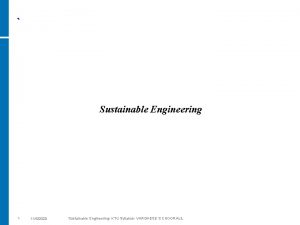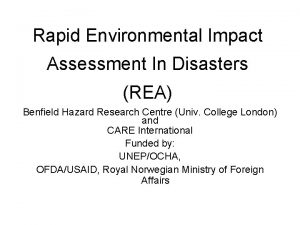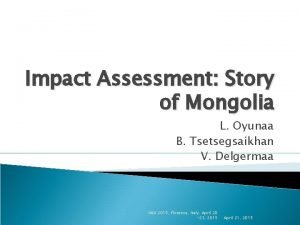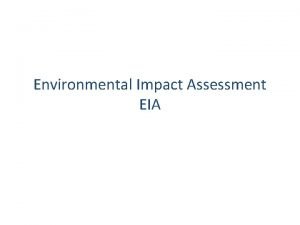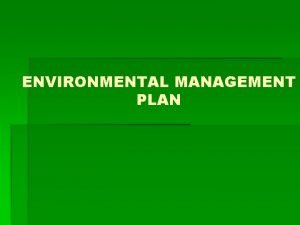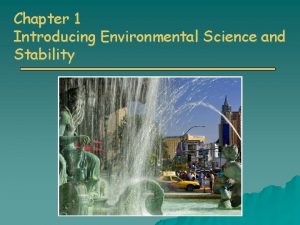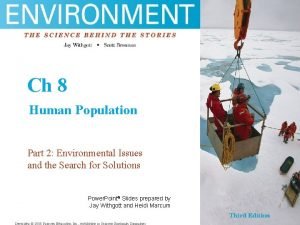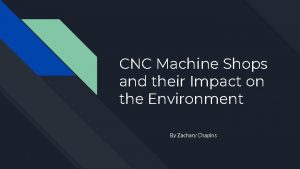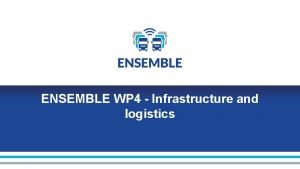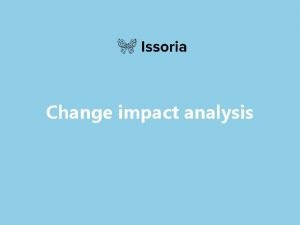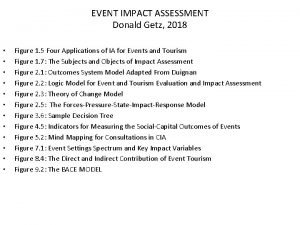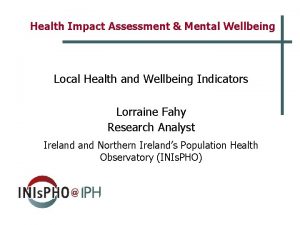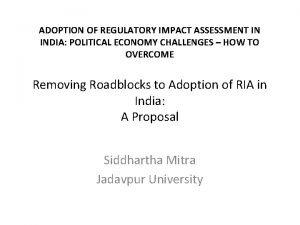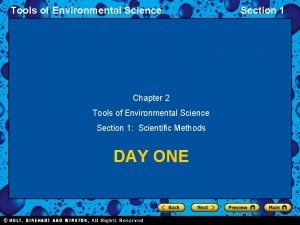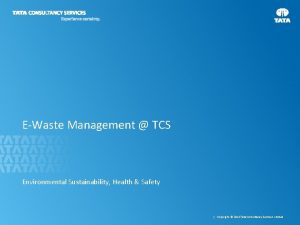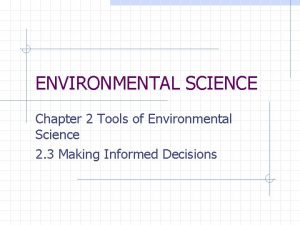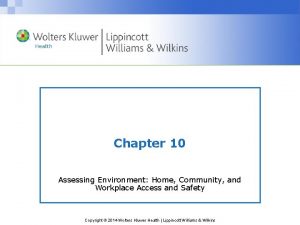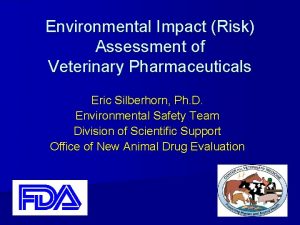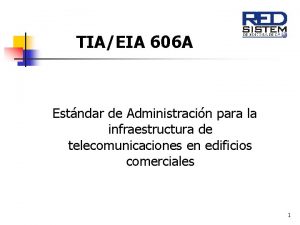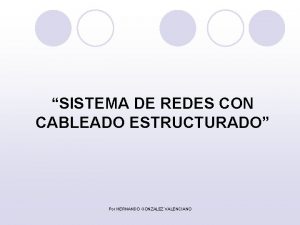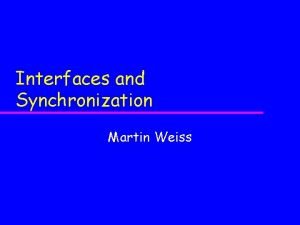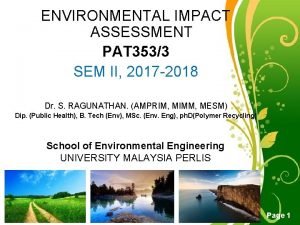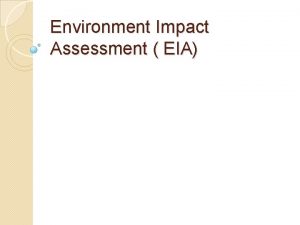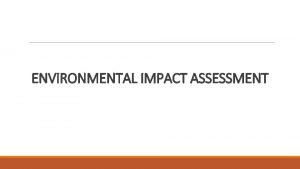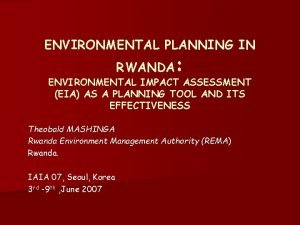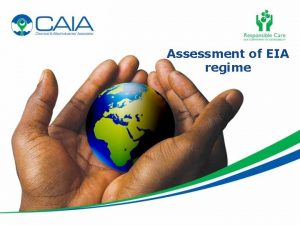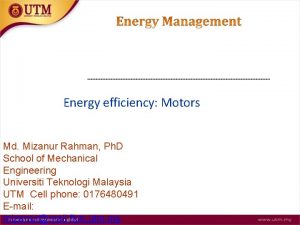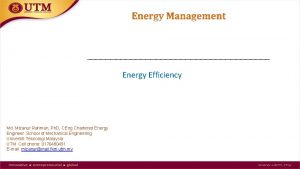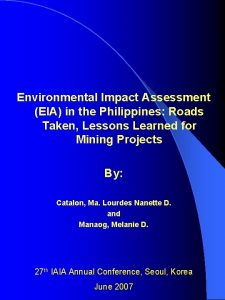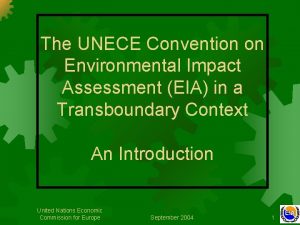Environmental Impact Assessment EIA Md Mizanur Rahman Ph





































- Slides: 37

Environmental Impact Assessment (EIA) Md. Mizanur Rahman, Ph. D

Origin of EIA • Before 1970 s, decision-making was based on economic analysis: – assess economic characteristics of a project and alternatives – select a project which maximizes benefits and minimizes costs • 4 factors lead to introduction of EIA global environmental consequences growing scale & impacts of resource developments upsurge in environmental activism inadequacies evident in public agencies undertaking developments • failure to incorporate environmental & social needs into decision-making • •

A Brief History of EIA • 1970’s: various industrial and developing countries introduced formal EIA requirements – Environmental Protection Act 1971 (W Australia) – Environment Protection (Impact of Proposals) Act 1974 (Cwlth) – France 1976, Philippines 1977, Netherlands 1978 • 1985 European Union Directive on EIA — came into force 1988 • 1989 EIAs became standard requirement for all World Bank financed investment projects • 1992 Rio Earth Summit - Principle 17: EIA, as a national instrument, shall be undertaken for proposed activities that are likely to have a significant adverse impact on the environment and are subject to a decision of a competent national authority. • Change in Focus: – natural/biophysical impacts initially – public involvement/demand broadening definition of environment – e. g. risk assessment, social (SIA), health, economic

4

Definitions • Assessment of environmental consequences (positive and negative) of a plan, policy, program, or project prior to the decision to move forward with the proposed action. • International Association for Impact Assessment (IAIA) defines: – Is the process of identifying the future consequences of a current or proposed action – Environmental impact assessment is a process of identifying, predicting, evaluating, and mitigating the biophysical, social, and other relevant effects of proposed projects and physical activities prior to major decisions and commitments being made.

Intention of EIA • EIA as a decision-making tool: – to identify likely environmental consequences by implementing a particular activity/project. – These information are used during the decision-making for that activity/project. – That enables the decision-makers to adopt the least environmental damaging alternative (incl. social & economic considerations). • EIA as a proactive planning tool, rather than a reactive remedial tool.

Intention of EIA • EIA as assessment of individual projects: – – In project planning Identifying potential impacts Proposing mitigation and management measures Decidign to proceed or not • Some effects of EIA Withdrawl of unsound projects Legitimation of sound projects Selection of improved project location Reformulation of plans redefinition of goals and responsibilities of proponents May discourage proponents from proposing environmentally damaging projects.

More functions • EIA as a tool for rational decision-making: – due to the systematic and scientific nature of EIA, rational decisions (information is available through logical thoughts) are possible. • EIA to influence proponents/internal reforms: – more environmental friendly business, integration of EIA into corporate & project level planning, employ specialist environmental staff, environmental management systems (EMS). • EIA to improve technical skills and knowledge: – data management process identify and collect information necessary for a particular decision to be made, determine likely environmental changes (compared with status quo), record analyse actual changes that occur. • EIA to enable public participation: – EIA opened up governmental activities to public analysis and participation, improved public consultation processes. • EIA as an environmental management tool: – ultimate goal of sustainable environmental management.

Objectives of EIA • To facilitate environmentally sound proposals by minimizing adverse impacts and maximizing benefit to the environment. • To ensure that proponents of proposals take primary responsibility for protection of the environment relating to their proposals. • To provide a basis for ongoing environmental management including changes in response to monitoring.

Evolution of EIA • Why do we need EIA? – the environment matters more than ever before. Human activities are altering the environment on an unprecedented scale. – risks and impacts are more significant than ever before. E. g. climate change, ozone hole, biodiversity – EIA provides basis for designing policies and plans that take account of environmental potentials and constraints, and for managing impacts and risks of activities

The EIA Process • Who is involved in the EIA Process? – developer or proponent: responsible for project planning & design (e. g. a big scale hydro power company) – competent authority: govt. dept. responsible for issuing approvals or permits (e. g. Dept. of Minerals & Energy) – other government authorities: may be affected by project (e. g. Dept. of Transport, Water Resources and local govt. ) – EIA administrator/regulator: responsible for EIA process and environmental protection from the government (e. g. EPA) – local community: need to know how the project will affect them – politician: ultimate decision-maker responsible for whether project proceeds (e. g. Minister for Environment)

The EIA process includes • Screening – to determine whether or not a proposal should be subject to EIA and, if so, at what level of detail. 12

• Screening It brings clarity and certainty to the implementation of EIA, ensuring that it neither entails excessive review nor overlooks proposals that warrant examination. usually keyed to likelihood of ‘significant impact’ occurring

• Approaches to screening: case-by-case discretion specific guidance for a class of developments screening lists identifying types of developments requiring assessment based on nature of development or receiving environment (e. g. size, location) Preliminary assessment is an option (where more information is needed)

• Scoping – to identify the issues and impacts that are likely to be important and to establish terms of reference for EIA. 15

• Organizations – competent authority sets out requirements for EIA process – proponent responsible for undertaking the work required – may engage consultants or employ specialist staff

• Scoping – What impacts and issues should be considered in the EIA? – valued ecosystem/environmental components’ should be focused upon during EIA study – Should you focus on predicting the impacts that are critical in terms of receiving approval for project or emphasize the manageable impacts about which something can be done? – What, if any, alternatives should be considered?

• Impact analysis – to identify and predict the likely environmental, social and other related effects of the proposal. 18

• Mitigation and impact management – to establish the measures that are necessary to avoid, minimise or offset predicted adverse impacts and, where appropriate, to incorporate these into an environmental management plan or system. • Evaluation of significance – to determine the importance or acceptability of residual impacts that cannot be tailgated. 19

• Preparation of environmental impact statement (EIS) or report – to document the impacts of the proposal, the significance of effects, and the concerns of the interested public and the communities affected by the proposal. 20

• Review of the EIS – to determine whether the report meets its terms of reference, provides a satisfactory assessment of the proposal(s) and contains the information required for decisionmaking. 21

Environmental Impact Statement (EIS) is a document that takes into consideration the environmental impact of a proposed action • EIS Preparation – should be integrated with project planning & design (not added afterwards) – identify likely impacts — data collection – make impact predictions – identify environmental management/mitigation strategies – prepare EIS for publication • Public Consultation – some consultation should occur during EIA study – EIS released for public comment – special public meetings may be held

• Decision-making – to approve or reject the proposal and to establish the terms and conditions for its implementation. – decision on whether to proceed with project – project acceptable as presented – project acceptable subject to special conditions – project unacceptable – usually made at a political level 23

• Follow up • • Monitoring Management Audit and evaluation to ensure compliance with the terms and conditions of approval; to monitor the impacts of development and the effectiveness of mitigation measures; and, where required, to undertake environmental audit and process evaluation to strengthen future EIA applications and mitigation measures and to optimise environmental management. 24

• Implementation – project proceeds according to approval conditions – impacts occur — mitigation measures enacted by proponent – regular monitoring of environmental performance by proponent – EIA auditing by EIA administrator/regulator (e. g. check compliance with approval conditions) – proponent responsible for management until after decommissioning or equivalent – knowledge & experience gained from EIA should feedback into other future projects

• Assessment at a Higher Level – a procedure for assessing the environmental implications of a decision to enact legislation and implement policies or plans – i. e. strategic environmental assessment (SEA). [SEA is a process designed to ensure that significant environmental effects arising from proposed plans and programmes are identified, assessed, subjected to public participation, taken into account by decision-makers, and monitored. SEA sets the framework for future assessment of development projects some of which require Environmental Impact Assessment (EIA); – http: //www. environment-gency. gov. uk/aboutus/512398/830672/]

Advantages of EIA • Tool for Rational Decision Making – rationality = informed logical thought – systematic nature of EIA e. g. S 102(a) of NEPA (National Environmental Policy Act) states that all agencies shall ‘utilise a systematic, interdisciplinary approach which will insure the integrated use of the natural and social sciences and the environmental design arts in planning and decision-making which may have an impact on environment • Influence Proponents/Internal Reform – greening of business – integrate EIA into corporate & project level planning • employ specialist environmental staff • environmental management systems (EMS) and corporate environmental reports (CER)

Advantages of EIA • Improve Technical Skills and Knowledge – data management process: – identify and collect information necessary for a particular decision to be made – determine likely environmental changes (compared with status quo) – record analyze actual changes that occur • Enable Public Participation – EIA opened up government activities to public analysis and participation – improved public consultation processes • EIA as an Environmental Management Tool – ultimate goal of sustainable environmental management

Problems with EIA Implementation • requirements for EIA may be avoided • EIA may not be part of proposal planning process – i. e. EIA not taken seriously tacked on afterwards — too late to change project no real consideration of alternatives EIA does not ensure sustainable projects decision-making focused on ‘environmentally acceptable’ projects • may be affected by political trade-offs • •

Problems with EIA Implementation • the nature of alternatives that are considered is important – e. g. coal fired power station • • EIA has project level emphasis — not strategic level cumulative effects are often not assessed public participation is often inadequate proposed mitigations may not be implemented legal basis of EIA and ability to ‘police’ it post-project monitoring is often lacking risk and social impacts often omitted from EIA controversial & value laden — more difficult than biophysical impacts • often hard/impossible to fund in development projects

Challenges • dealing with global environmental issues • integrating EIA with assistance programmes for developing countries • EIA and international trade, multi-national businesses • sustainability assessment

Impact prediction and Identification • What is Impact Prediction? – Predictions of possible impacts caused by the implementation of certain development activities based on the available baseline data on environmental conditions. – Predictions should be described in quantitative and qualitative terms. • What is impact identification? – establishes the possible consequences (impacts) of a given set of activities on environmental elements • Why is impact identification needed? – provides a structure to the EIA study – boundaries of EIA study – range of potential impacts – provides important input for impact prediction

Impact prediction and Identification • The following impact categories are identified (IUCN, 1993, p 8): – Socioeconomic Impact (activities that would bring changes to the existing economic and social conditions of the communities within the project area) – Biological and Physiochemical Impact (effects on vegetation, wildlife, crops and aquatic life) – Cultural Impact (activities that would bring changes to cultural and religious heritage of a community) • Impact identification steps: – describe the activity components – identify & describe the sources/causes of impacts – describe the environmental components – identify & describe primary/direct impacts – identify higher order/indirect impacts – adequately represent information

Techniques for identifying impacts • Copy previous EIA documents and procedures and use it for the intended context: – Advantages: quick and easy – Disadvantages: May repeat mistakes • Educate guessing – Advantages: useful in determining liking impacts – Disadvantages: not a representative technique, inconsistent project specific

Two different helpful typical simple checklists

· a ·. . - Adlverse Beneficial 13 m $ ii ll. J I I 1 ISurface wafer hydrology Swface wafer qum. ity· n i novative • entrepreneurial • global . . . J tl I! Fl I I 8 w? = C J w : '9 . . J Qll . 0 00 0 e u: . . J 0 : : E z 0 • rli X X X X IX X X IX X II I I 7 I II X X XII X X I X ·i tr. ! X Groundwateri IIAir quality IN vigation Land t. ransportation I Agriculwe Socio-economic· IAesthetic 0 X 1 . )51 m. . IX Agua. tic ecosystems Fi. Lsheries F ms. ts ITerres trial vildlife endangered species Rare s ibr: $ pm X X I w w w. u t rn. m y

Self Study – Energy Management Programmes for Industry (by IEA)
 Md mizanur rahman pilot
Md mizanur rahman pilot Md mizanur rahman dream paris
Md mizanur rahman dream paris Mizanur rahman
Mizanur rahman Mizanur rahman
Mizanur rahman Mcn 201 sustainable engineering ktu syllabus
Mcn 201 sustainable engineering ktu syllabus Rapid environmental impact assessment in disaster
Rapid environmental impact assessment in disaster What is environmental impact assessment
What is environmental impact assessment Need for environmental impact assessment
Need for environmental impact assessment Importance of green management
Importance of green management Ipat model of environmental impact
Ipat model of environmental impact Ipat model
Ipat model Whats the domino theory
Whats the domino theory Ipat model of environmental impact
Ipat model of environmental impact Ipat model
Ipat model Impact of tidal energy on environment
Impact of tidal energy on environment Environmental impact of cnc machining
Environmental impact of cnc machining Wireless health
Wireless health Business impact analysis vs risk assessment
Business impact analysis vs risk assessment Experience assessment cipd
Experience assessment cipd Viscoroute
Viscoroute Change impact assessment template
Change impact assessment template Event impact assessment
Event impact assessment Labour market impact assessment lmia online web application
Labour market impact assessment lmia online web application Mental wellbeing impact assessment
Mental wellbeing impact assessment Mental wellbeing impact assessment
Mental wellbeing impact assessment Regulatory impact assessment india
Regulatory impact assessment india Environmental science section 2 review answers
Environmental science section 2 review answers Environmental management system at tcs
Environmental management system at tcs Chapter 2 assessment environmental science
Chapter 2 assessment environmental science Environmental assessment fda
Environmental assessment fda Workplace environmental assessment
Workplace environmental assessment Environmental risk assessment veterinary
Environmental risk assessment veterinary Facility manager
Facility manager Tia/eia 606a
Tia/eia 606a Ansi/tia/eia-606-a
Ansi/tia/eia-606-a Earned value management systems eia-748-c intent guide
Earned value management systems eia-748-c intent guide Eia-232-d
Eia-232-d Eia process
Eia process




